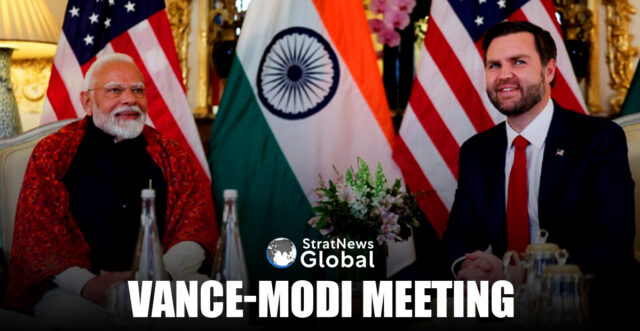U.S. Vice President JD Vance, currently on a four-day official visit to India, held a closed-door meeting with Prime Minister Narendra Modi on Monday, amid growing global economic uncertainty driven by the ongoing U.S.-China trade tensions.
Following their private discussion, both leaders participated in delegation-level talks.
These high-level engagements coincide with India and the United States progressing toward finalising a bilateral trade agreement aimed at boosting mutual economic interests.
President Donald Trump had earlier imposed a steep 26% tariff—on top of an existing 10%—on Indian exports.
However, this additional “reciprocal” tariff has been temporarily suspended for 90 days. Economists believe this pause offers a strategic window for both nations to finalise a “win-win” trade deal.
A Vital Strategic Partnership
India and the United States enjoy a strong and evolving partnership, often described as a cornerstone of democratic cooperation—linking the world’s oldest democracy with its largest.
The White House has reaffirmed that strengthening ties with India remains a top priority for the Trump administration, especially as Washington seeks to blunt the economic impact of its standoff with China, the world’s manufacturing powerhouse.
Indian officials have suggested that the trade deal, originally targeted for the autumn, is now being fast-tracked with hopes of completion by the end of July—despite the timing coinciding with India’s monsoon season.
However, New Delhi has made it clear that it will not be pressured into finalising any deal that doesn’t address its core concerns. “India will not sign a deal at gunpoint,” one official stated.
According to a Bloomberg report citing unnamed Indian officials, sector-specific negotiations are expected to begin this week, following the Modi-Vance meeting. There’s also speculation that a new target date—possibly the end of May—may be set for concluding the talks.
Finance Minister Nirmala Sitharaman is scheduled to travel to Washington soon for the IMF meetings, where she is expected to hold advanced-level discussions with senior US officials to push the trade talks forward.
Boosting US Investment In India
India is also actively seeking greater American investment, especially in key sectors such as technology, manufacturing, automotive, and energy.
Just last week, Prime Minister Modi spoke with tech billionaire Elon Musk. Following the call, Elon Musk—who owns Tesla, SpaceX, and Starlink—hinted at a visit to India later this year, potentially signalling entry into the Indian market where his companies currently have no footprint.
In a separate milestone, India and the US marked a significant breakthrough in their civil nuclear cooperation. The US Department of Energy recently gave final approval for a US-based firm to co-design and build nuclear power plants in India.
The company in question, Holtec International, is led by Indian-American entrepreneur Krishna P. Singh. Holtec Asia, the firm’s wholly-owned subsidiary, has operated out of Pune since 2010 and also runs a manufacturing unit in Dahej, Gujarat.
Reports also indicate that American companies are looking to ramp up production of consumer electronics—including laptops, tablets, and smartphones—in India.
This aligns with Washington’s broader strategy to reduce supply chain reliance on China. With India already a global leader in mobile phone manufacturing, it presents a compelling alternative for US firms looking to diversify.
(With inputs from IBNS)





